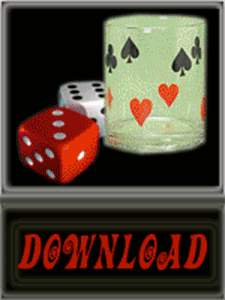Pokerwiner.com → Lessons of poker
GAME THEORY AND BLUFFING FREQUENCY ACCORDING TO YOUR OPPONENTS
In actual holdem poker situations, optimum strategy based on game theory is not always the best strategy. Obviously if you are up against an opponent who almost always calls you, then you shouldn’t bluff at all.
By the same token, if you are up against someone who folds too much, you should bluff with some frequency.
Game theory bears out these shifts in strategy. Notice in the first part of this chapter that if you bluffed with five cards instead of six that is, slightly less than optimally you would win $300 more per 42 hands if your opponent called rather than folded every time.
However, if you bluffed with seven cards instead of six, you would win $300 more if your opponent folded rather than called every time.
Here is where a player’s judgment supersedes optimum game theory strategy: He would bluff a little less against opponents who call too much and a little more against opponents who fold too much.
Good, intuitive players understand this concept. If they notice they have folded on the end a few hands in a row, they are ready to call next time.
Otherwise players will start holdem bluffing them. And they use similar considerations in deciding whether to bluff themselves.
It is against such expert players, whose calling and folding are right on target, or whose judgment is as good as or better than yours, that game theory becomes the perfect tool. When you use it, there is no way they can outplay you.
Summary of Game Theory as a Tool for Bluffing
When using game theory to decide whether to bluff, you must first determine your chances of making you hand. You must then determine the odds your opponent is getting on that bet.
Then you must randomly bluff in such a way that the odds against your bluffing are identical to your opponent’s
pot odds.
Here’s one more example. Suppose you have a 20 percent chance of making you hand, there’s $100 in the pot, and the bet is $25.
Your opponent is then getting $125-to-$25 or 5-to-1 odds if you bet. The ratio of your good poker hands to your bluffs should, therefore, be 5-to-1.
Since you have a 20 percent chance of making your hand, you should randomly bluff 4 percent of the time. (20 percent-to-4 percent equals 5-to-1.) When you bluff in this fashion, you take optimum advantage of the situation.
A good, convenient way to randomize your bluffs, as we have seen, is to pick cards from among those you haven’t seen.
If, for example, ten cards make your hand and you need a 5-t-1 bluffing ratio, then you should pick two additional cards to bluff with.
Here is another example. You draw one card to a spade flush in draw poker, and your opponent draws three cards.
Therefore, the chances are enormous that your opponent will not be able to beat a flush, only a bluff. The pot contains $20.
The bet is $10. If you bet, your opponent is getting $30-to-$10 or 9-to-3 odds from the pot. Since nine unseen spades make your flush, you should pick three additional cards to bluff with, such as the two red 4s and the 4 of clubs.
You now bet with twelve cards creating a 9-to-3 ratio between your good hands and your bluffs. It is not always possible to use cards to arrive at exactly the ratio you need to bluff optimally.
However, as long as you are close, you can still expect to gain.
You recall that choosing six cards to bluff with in the draw lowball example created exactly the right
proportion vis-à-vis the pot odds my opponent was getting; nevertheless, I still ended up with a profit when I bluffed with five or with seven cards whether my opponent called or folded. Of course, the closer you are to the exact ratio, ratio, the better, in terms of poker game theory.



